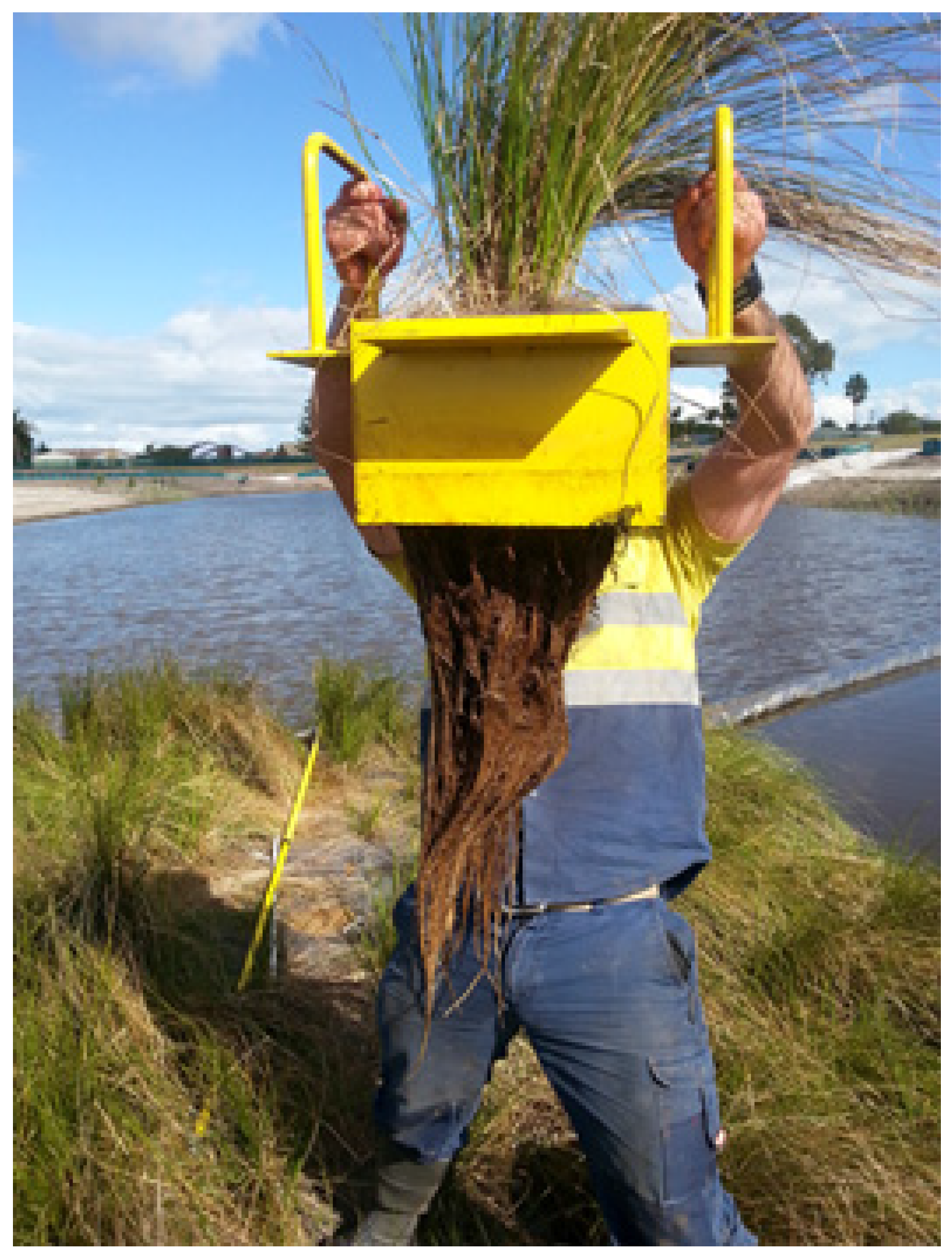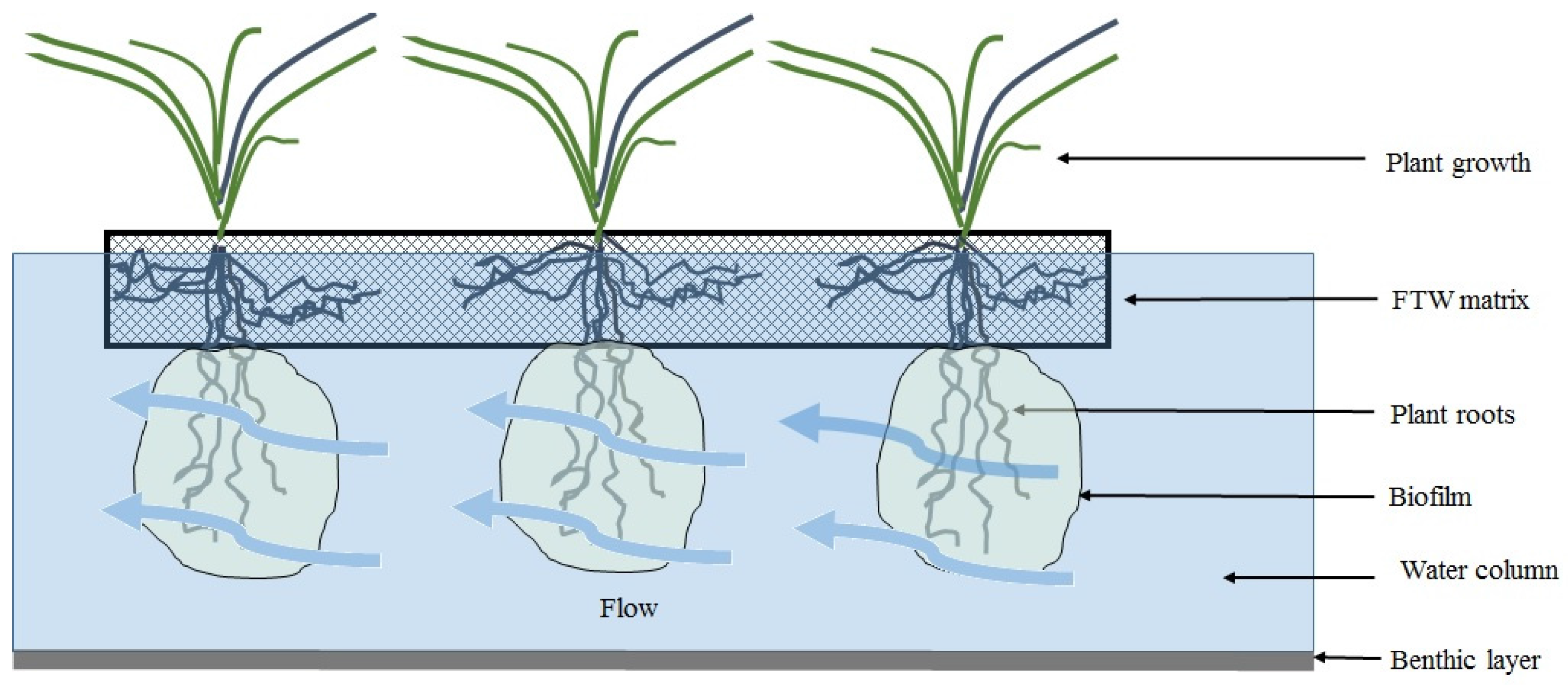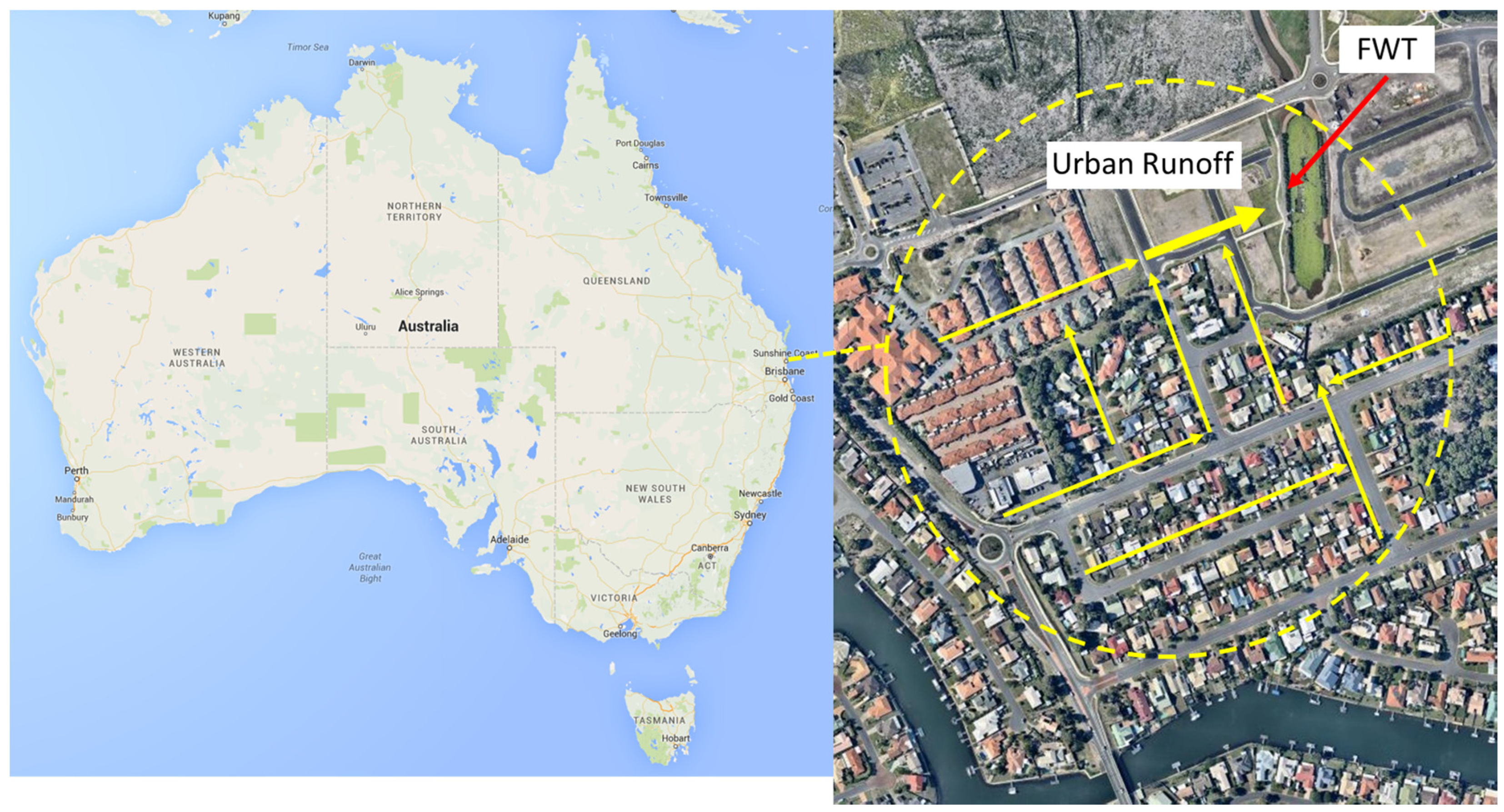1. Introduction
Naturally occurring floating vegetated islands are found in freshwater lakes and ponds, and are comprised of a matrix of floating organic material and plant associations growing at the water surface. The buoyancy of a naturally occurring floating island is a result of gasses (Nitrogen-N and Carbon dioxide-CO
2 in aerobic conditions, and additionally Methane-CH
4 in anoxic conditions) trapped beneath the organic mat, and the air stored within the roots and leaves of vegetation growing on the island [
1,
2]. The size of naturally occurring floating islands can change organically over time, increasing via the accumulation of trapped floating organic material, and decreasing because of temporary higher velocity flows, wave action, or strong winds [
1]. The inherent habitat value (especially to avifauna) of floating islands has been recognised for decades [
3]. For example, the UK Royal Society for the Protection of Birds constructed artificial islands for the conservation of threatened species as early as the 1960’s [
4].
Following these early successes, FTWs have since been used for a variety of purposes including treatment of pollution emanating from mine tailings [
4,
5,
6,
7], and pollution removal from stormwater [
8,
9,
10,
11,
12,
13,
14]. FTWs make positive contributions to the health of their aquatic environment by reducing flow velocity which promotes the settlement of suspended solids. FTWs also mechanically filter suspended solids though the interaction of plant roots in the water column (
Figure 1) which can grow to a depth of 3 m [
3]. Complex microbial communities (biofilm) also assemble on, and throughout the root mass below the water surface, and contribute to water treatment processes through adhesion, filtration, nutrient uptake (direct use by plants), and sequestration [
15,
16]. FTWs have also been acknowledged to contribute to the aesthetic quality of an area [
4]. As FTWs do not require additional earthworks or land uptake, they can also offer increased pollution removal performance at a substantially lower cost compared to alternatives such as constructed wetlands.
Contemporary artificial FTWs are typically constructed using a combination of woven plastic, organic based matting, and fibreglass [
8,
10]. Juvenile plants are established directly into this floating matrix, and the roots grow into the water column below (
Figure 2).
Studies undertaken in the United States and New Zealand [
10,
11,
12,
13,
14,
15,
16] have found that FTW can provide an effective, low cost, and low maintenance means of treating domestic and agricultural wastewater and stormwater. Tanner
et al. [
10] found that FTW were capable of reducing wastewater TSS by up to 81%, total nitrogen (TN) by up to 34%, and total phosphorus (TP) by up to 19%. Borne [
11] observed significant reductions in TP as a result of a FTW installation in a stormwater pond. Similarly Borne
et al. [
12] in NZ found FTW retrofitted stormwater ponds to be more efficient at removing TSS. However, there are currently few field studies on the performance of FTW in treating urban stormwater runoff [
9] and their treatment performance remains largely unknown. This paper describes the results of a twelve-month field study undertaken to evaluate the pollution removal performance of a FTW designed to treat stormwater runoff from an existing urban development in Queensland, Australia.
2. Site Description
The study site was located on Bribie Island, Queensland, Australia (
Figure 3). The entire site is zoned low-density residential, and has a total area of 42.3 ha. The contributing catchment area of the development site treated by the FTW is 7.46 ha (
Figure 3), with 2.2 ha comprised of a development under construction. The FTW installation (101 m
2) was sized as approximately 0.14% of the contributing catchment area.
Rainfall and runoff from the catchment is directed via road kerb inlets (catch basins), and a piped drainage network to a stormwater channel leading to the lake containing the FTW. Flow from the channel was immediately directed to the FTW treatment zone with flexible, impermeable polyvinyl chloride (PVC) curtains which were secured to the sides of the FTW and the pond bed. This was done to prevent short-circuiting of the flows (a problem identified in previous studies). Water samples were taken at the FTW inlet and outlet points shown in
Figure 4.
The modular FTW was constructed using four, 50 mm thick layers of recycled plastic fibre, with injected marine grade foam to provide buoyancy (
Figure 4). This matrix was then covered with a natural coir mat, and initially planted out with a sedge mono-culture (
Carex appressa) at a density of approximately three plants/m
2. Each of the 11 individual FTW modules was 9.2 m
2 in area (total area of 101 m
2). The size of the forebay area during testing was 130 m
2. Because of the installation of the impermeable baffles, the FTW covered 100% of the treated surface area. The overall size of the pond was 5048 m
2.
3. Sampling Protocol and Methodology
A predetermined sampling protocol was used to identify qualifying rainfall events (
Table 1). This protocol was developed in order to support an objective evaluation of the FTW pollution removal performance, which could be viewed as “representative performance” across the wide range of variable inflow pollution concentration likely to be experienced by the FTW in an urban residential setting. This protocol was developed based on the protocol methodology prescribed by the United States Environmental Protection Agency’s (USEPA) Stormwater BMP Monitoring Manual [
17] and Auckland Regional Council’s Proprietary Device Evaluation Protocol (PDEP) for Stormwater Quality Treatment Devices [
18].
Automatic sampling equipment was triggered when a tipping bucket rain gauge recorded >2 mm rainfall in 30 min, and the flow meter (Starflow ultrasonic probe) simultaneously recorded >0.5 L/s. Samples were collected by the auto-samplers at 5000 L intervals thereafter until flow ceased. To account for the potential lag in flow beneath the FTW, a further two sub-samples were taken after flow had dropped below 0.5 L/s for 60 min. Sample aliquots (200 mL) were composited within the automatic sampler in a nine litre glass bottle for analysis.
4. Results and Discussion
During twelve months of monitoring, 10 qualifying events were recorded (
Table 2 and
Table 3) with rainfall depths ranging between 2.0 mm and 25.6 mm. As expected, the observed pollution removal efficiencies were highly-variable between individual rainfall events for the parameters measured. The measured pollution removal performance (ER) of the FTW was calculated to be 80% for TSS, 53% for TP, and 17% for TN (
Table 2. These removal rates are encouraging when compared to findings of previous stormwater FTW pond studies [
11,
12,
13,
14]. The improved removal rates are believed to be the result of the unique experimental design that excluded potential short-circuiting and specifically focused on evaluating the pollution removal performance of the field-scale FTW alone, rather than as part of a stormwater treatment train. The calculated pollution removal proportions from outflows were found to be less than the values specified by the local Queensland State Planning Policy and regulations (TSS 80%, TP 60%, and TN 45%) [
21], and this is likely a reflection of the small FTW footprint as a percentage of the contributing catchment [
22]. Calculations of the ER for TN were particularly variable. This may have been due to very low pollution influent concentrations during some of the qualifying events and the strong dependence of nutrient removal rate on loading rate as found in previous studies [
11].
Rainfall, peak flow rates and cumulative flow volumes were used to calculate the Sum of Loads for evaluating the performance of the FTW in removing pollution loads from urban stormwater from the study site (
Table 4). The low load removal for TN is thought to be a result of the highly variable TN inflows. More qualifying sampling events (> 150) are required to fully incorporate this variability.
A paired Student’s
t test (log transformed data) was performed to test for differences between inflow and outflow pollution concentrations. The results showed that TSS and TP outflow concentrations were significantly lower than inflow concentrations (
p < 0.05) (
Table 5).
These results demonstrate how highly-variable environmental data may require very large datasets to establish pollution removal efficiencies that are statistically significant using the traditional calculations [
22]. Equation (6) was used to estimate the number of samples required to ensure a statistical relevant result (
Table 6).
An estimated 23-year period would be required to adequately demonstrate statistical significance for the results of the full range of parameters investigated in this study (
Table 6). Given the high establishment and running costs of research projects such as this, and the low proportion of qualifying events arising from natural rainfall that were able to be successfully sampled (<20%), this time frame was considered to be unrealistic.
5. Conclusions
This research investigated the pollution removal performance of a FTW receiving stormwater runoff from a 7.46 ha urban residential catchment. The FTW installation (101 m2) was sized as approximately 0.14% of the contributing catchment. The FTW was initially planted with a sedge mono-culture (Carex appressa). The installation of impermeable baffles ensured the FTW covered 100% of the water treatment zone, and also prevented short-circuiting of the flows.
As anticipated, there was a high degree of variation in FTW treatment performance between individual rainfall events. Overall Efficiency Ratio was calculated to be 80% TSS removal, 53% TP removal and 17% TN removal for a FTW footprint of 0.14% of the contributing catchment. TSS and TP outflow concentrations were found to be significantly reduced after FTW treatment (p < 0.05). Sum of loads calculations based on flow resulted in pollution load reductions of TSS 76%, TP 55%, and TN 17%. Treatment performance (particularly for TN) was found to be affected by very low and highly variable inflow concentrations. Because of this high degree of variability, an estimated 23-year period would be required to adequately demonstrate statistical significance for the full range of parameters investigated in this study.
This study has demonstrated that FTWs are an effective treatment solution for the removal of pollution from urban stormwater runoff, though may need to be larger than 0.14% of the contributing catchment to achieve 80% TSS, 60% TP and 45% TN locally regulated water quality objectives. Using a simple linear assumption mathematical model, the minimum proportional size of the FTW to catchment required to achieve the required pollution removal rates was calculated to be 0.37% or at this site, 124 m2. As FTWs do not require additional earthworks or land uptake, they may also offer pollution removal at substantially lower costs than other more traditional treatment options. It is expected that the performance of FTWs could be even further improved when used in conjunction with additional treatment components as part of a “treatment train” approach.
Given the potential for FTWs to successfully treat stormwater runoff and the few reported field studies specifically relating the performance of FTWs and nutrient removal [
9,
10], this study makes a notable contribution to the current body of knowledge in this area. The Stormwater Research Group University of the Sunshine Coast currently has a number of additional study trials underway which are investigating the long-term pollution removal performance of FTW systems in urban settings. It is anticipated that the effective pollution removal performance of FTWs will be clearly demonstrated in future as more results from these ongoing studies are evaluated.











